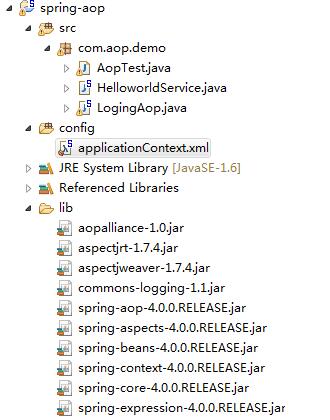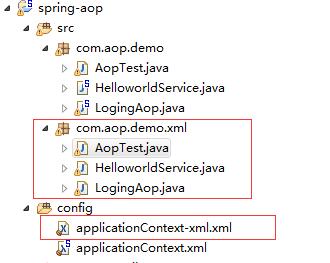spring AOP (包含基于注解和配置文件两种方式)
Posted
tags:
篇首语:本文由小常识网(cha138.com)小编为大家整理,主要介绍了spring AOP (包含基于注解和配置文件两种方式)相关的知识,希望对你有一定的参考价值。
spring AOP?面向切面编程,区别于面向对象编程OOP
AspectJ: 是Java社区里面最完整最流行的AOP框架,下面就用aspectJ来上例子
一.基于注解方式
步骤如下:
- 引入jar包(spring的必要jar包 以及aspectj的jar包)
- 业务方法HelloworldService (类上加上注解@Component,放入到spring ioc容器中)
- 切面LogingAop (类上加上注解@Component使其加入到ioc容器中,还需要注解@Aspect,使其成为一个切面)
- spring配置文件applicationContext.xml (扫描包,以及aop生成代理类的配置<aop:aspectj-autoproxy/>)
- 测试
结构如下:

HelloworldService代码实现:
package com.aop.demo; import org.springframework.stereotype.Component; @Component public class HelloworldService { public int add(int i, int j){ return i+j; } }
LogingAop代码实现:
package com.aop.demo; import java.util.Arrays; import java.util.List; import org.aspectj.lang.JoinPoint; import org.aspectj.lang.annotation.Aspect; import org.aspectj.lang.annotation.Before; import org.aspectj.lang.annotation.Pointcut; import org.springframework.stereotype.Component; @Component @Aspect public class LogingAop { @Pointcut("execution(public int com.aop.demo.HelloworldService.add (int,int))") public void pointcut(){}; @Before(value="pointcut()") public void beforeMethod(JoinPoint jointPoint){ String methodName = jointPoint.getSignature().getName(); List args = Arrays.asList(jointPoint.getArgs()); System.out.println("Method("+methodName+") args("+args+") Start"); } }
applicationContext.xml中配置
<?xml version="1.0" encoding="UTF-8"?> <beans xmlns="http://www.springframework.org/schema/beans" xmlns:xsi="http://www.w3.org/2001/XMLSchema-instance" xmlns:aop="http://www.springframework.org/schema/aop" xmlns:context="http://www.springframework.org/schema/context" xsi:schemaLocation="http://www.springframework.org/schema/beans http://www.springframework.org/schema/beans/spring-beans.xsd http://www.springframework.org/schema/context http://www.springframework.org/schema/context/spring-context-4.0.xsd http://www.springframework.org/schema/aop http://www.springframework.org/schema/aop/spring-aop-4.0.xsd"> <context:component-scan base-package="com.aop.demo"></context:component-scan> <aop:aspectj-autoproxy/> </beans>
测试代码如下
package com.aop.demo;
import org.springframework.context.ApplicationContext;
import org.springframework.context.support.ClassPathXmlApplicationContext;
public class AopTest {
public static void main(String[] args) {
ApplicationContext ctx = new ClassPathXmlApplicationContext("applicationContext.xml");
HelloworldService helloworldService = (HelloworldService) ctx.getBean("helloworldService");
int result = helloworldService.add(1, 2);
System.out.println("Result is "+result);
}
}
测试结果如下:
Method(add) args([1, 2]) Start
Result is 3
AOP中的概念介绍:
切面:跨越应用程序多个模块的功能,比如打日志,比如参数验证,类似这种被模块化的特殊对象
通知: 上面切面中的方法
切入点:相当于查询条件,在哪些业务方法中需要加入通知,spring自动生成新的代理对象
AspectJ支持5中类型的通知注解:
@Before: 前置通知,在方法执行之前执行
@After: 后置通知,在方法执行之后执行 (不管是否有异常,都会执行)
@AfterRuning: 返回通知,在方法返回结果之后执行 (只在没有异常时候才执行)
@AfterThrowing: 异常通知,在方法抛出异常之后
@Around: 环绕通知,围绕着方法执行
AspectJ的5中注解的代码示例
package com.aop.demo; import java.util.Arrays; import java.util.List; import org.aspectj.lang.JoinPoint; import org.aspectj.lang.ProceedingJoinPoint; import org.aspectj.lang.annotation.After; import org.aspectj.lang.annotation.AfterReturning; import org.aspectj.lang.annotation.AfterThrowing; import org.aspectj.lang.annotation.Around; import org.aspectj.lang.annotation.Aspect; import org.aspectj.lang.annotation.Before; import org.aspectj.lang.annotation.Pointcut; import org.springframework.stereotype.Component; @Component @Aspect public class LogingAop { @Pointcut("execution(public int com.aop.demo.HelloworldService.add (int,int))") public void pointcut(){}; @Before(value="pointcut()") public void beforeMethod(JoinPoint jointPoint){ String methodName = jointPoint.getSignature().getName(); List args = Arrays.asList(jointPoint.getArgs()); System.out.println("Method("+methodName+") args("+args+") Start"); } @After(value="pointcut()") public void afterMethod(JoinPoint jointPoint){ String methodName = jointPoint.getSignature().getName(); List args = Arrays.asList(jointPoint.getArgs()); System.out.println("Method("+methodName+") args("+args+") After"); } @AfterReturning(value="pointcut()",returning="result") public void afterReturingMethod(JoinPoint jointPoint,Object result){ String methodName = jointPoint.getSignature().getName(); List args = Arrays.asList(jointPoint.getArgs()); System.out.println("Method("+methodName+") args("+args+") After Runing + Result:"+result); } @AfterThrowing(value="pointcut()",throwing="e") public void afterThrowingMethod(JoinPoint jointPoint,Exception e){ String methodName = jointPoint.getSignature().getName(); List args = Arrays.asList(jointPoint.getArgs()); System.out.println("Method("+methodName+") args("+args+") After Throw Exception:" +e); } @Around(value="pointcut()") public Object aroundMethod(ProceedingJoinPoint jointPoint){ Object result = null; String methodName = jointPoint.getSignature().getName(); try { System.out.println(methodName+"前置通知....."); result = jointPoint.proceed(); System.out.println("后置通知....."); } catch (Throwable e) { System.out.println("异常通知....."); throw new RuntimeException(); } System.out.println("返回通知....."); return result; } }
注意:@Around环绕通知,必须携带对象ProceedingJoinPoint参数
环绕通知类似于动态代理的全部过程,可以决定是否执行目标方法
切面的优先级
可以在切面上注解@Order,其中值越小,切面的优先级越高

二.基于配置文件方式
步骤如下:
- 将上面的三个类移到其他包里面,去掉类以及方法中的所有注解
- 定义新的配置文件applicationContext-xml.xml
结构如下:

applicationContext-xml.xml的配置
<?xml version="1.0" encoding="UTF-8"?> <beans xmlns="http://www.springframework.org/schema/beans" xmlns:xsi="http://www.w3.org/2001/XMLSchema-instance" xmlns:aop="http://www.springframework.org/schema/aop" xmlns:context="http://www.springframework.org/schema/context" xsi:schemaLocation="http://www.springframework.org/schema/beans http://www.springframework.org/schema/beans/spring-beans.xsd http://www.springframework.org/schema/context http://www.springframework.org/schema/context/spring-context-4.0.xsd http://www.springframework.org/schema/aop http://www.springframework.org/schema/aop/spring-aop-4.0.xsd"> <!-- 配置业务bean --> <bean id="helloworldService" class="com.aop.demo.xml.HelloworldService"></bean> <!-- 配置切面 --> <bean id="logingAop" class="com.aop.demo.xml.LogingAop"></bean> <!-- 配置AOP --> <aop:config> <aop:pointcut expression="execution(public int com.aop.demo.xml.HelloworldService.add (int,int))" id="pointCut" /> <aop:aspect ref="logingAop"> <aop:before method="beforeMethod" pointcut-ref="pointCut" /> </aop:aspect> </aop:config> </beans>
以上是关于spring AOP (包含基于注解和配置文件两种方式)的主要内容,如果未能解决你的问题,请参考以下文章